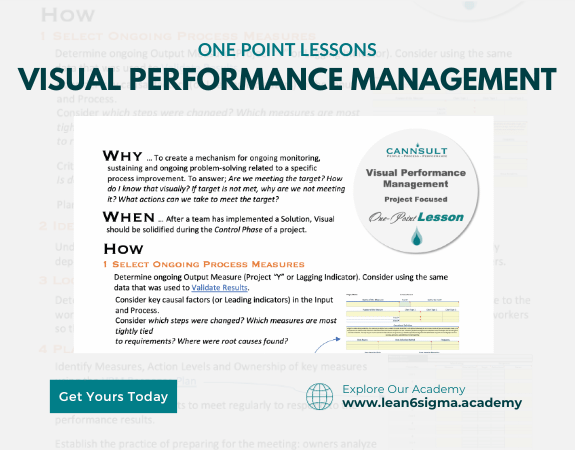Project Visual Performance Management
Accountability
Improved project oversight and control
Early identification of issues and risks
Visual display
Drive Action!
Enhanced communication and collaboration
Increased project success rates
Project Visual Performance Management is a method of using visual tools and techniques to monitor, communicate, and improve the performance and progress of projects.
Description:
Project Visual Performance Management is a project management approach that relies on visual aids and techniques to provide real-time insights into a project's status, performance, and outcomes. It enhances transparency, communication, and decision-making throughout the project lifecycle.
Key Elements of Project Visual Performance Management:
Visual Dashboards: Utilize visual dashboards that display key project metrics and performance indicators in an easily understandable format.
KPIs and Metrics: Define and track key performance indicators (KPIs) and metrics that are critical to project success.
Progress Tracking: Continuously monitor project progress, milestones, and deadlines.
Risk Identification: Visual tools can help identify and assess project risks and issues in a more intuitive way.
Communication: Visual displays make it easier to communicate project status to stakeholders, including team members, sponsors, and clients.
Steps in Implementing Project Visual Performance Management:
Identify Key Metrics: Determine which metrics and KPIs are most relevant to your project's goals and objectives.
Select Visual Tools: Choose appropriate visual tools and formats, such as Gantt charts, Kanban boards, or project dashboards.
Regular Updates: Ensure that project data is updated regularly and accurately to provide a current view of project performance.
Accessibility: Make project visual performance management tools and information accessible to all relevant stakeholders.
Training: Provide training to team members and stakeholders on how to interpret and use the visual tools effectively.
Benefits of Project Visual Performance Management:
Improved project oversight and control
Enhanced communication and collaboration
Early identification of issues and risks
Informed decision-making
Increased project success rates
Key Takeaway:
Project Visual Performance Management leverages visual tools and techniques to monitor and improve project performance. By providing clear and real-time insights, it enhances project oversight, communication, and the likelihood of successful project outcomes.

0 Reviews
Riaan is a dynamic leader, coach, facilitator, Lean Six Sigma Master Black Belt with over 20 years of hands-on experience driving business results. Riaan is highly skilled and has worked across diverse industries internationally. With a degree in Chemical Engineering, Riaan started in the major breweries and bakeries in South Africa and was so dedicated to his work that he was often known to take his work home with him.
